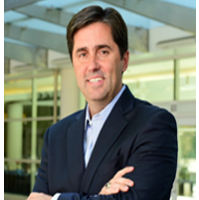
Sponsored by
Kuehne+Nagel’s Rob Coyle, SVP, Pharma & Healthcare Strategy; and Craig Brodie, Vice President, Business Development, Integrated Logistics Americas; discuss how fourth-party logistics (4PL) solutions can orchestrate and integrate all elements of the supply chain.
 Rob Coyle
Rob Coyle  Craig Brodie
Craig Brodie
What is Kuehne+Nagel’s expertise in the healthcare sector?
Craig Brodie: We work with a range of clients in the healthcare sector, from consumer health to biopharma, vaccines, medical devices and big pharma. We work alongside clients to ensure their customers – the patients – have access to the products they need, when they need them. That requires logistics planning across all legs of the supply chain, as well as more strategical and management services, such as sourcing, continuous improvement, market intelligence, benchmarking and net-zero carbon. All these aspects make our clients’ supply chains more visible, resilient and sustainable not just for the present, but as we support our customer’s supply chains to evolve in the future.
Rob Coyle: In order deliver for our customers, we have to have the same mindset as them. In the healthcare vertical, our philosophy, which we introduced in May 2018, is “For when it matters the most”. Our focus is on the patients. People rely on pharmaceutical drugs, biopharmaceuticals, med-tech, or over-the-counter medicines to live a better life. “For when it matters the most” is our way to ensure the mindset that we’re not just shipping boxes, we’re not just executing in the 4PL world – we play a key role in the supply chain and this makes a difference.
Previously, what we did was always behind the scenes, right up until the pandemic. Now it’s on the evening news. But it was perfect timing for us to be thinking about “For when it matters the most” because there was a need to ensure the supply of products. There were a lot of constraints on the market, but we were still successful because of that patient focus.
How do you help customers improve what they do?
Rob Coyle: We focus on what matters most for the client: quality, service compliance and cost. This is a regulated supply chain, so it’s about delivering services as promised, and when you’re dealing with patients and loved ones in healthcare, you have to be perfect.
What are some of the typical challenges your customers are facing?
Craig Brodie: Visibility, resilience, reliability and having confidence in the product arriving as and when it’s expected. The pandemic has impacted overall business results, including higher transport costs, increased inventory holding, or loss of market share. We’re also starting to see more focus within the healthcare vertical on sustainability.
Visibility has been a huge challenge through the pandemic, as customers have wanted to know exactly where their containers, trucks or airfreight shipments are located. With our digital platform we’re providing them with complete visibility. It’s about giving them the certainty, which has been a struggle during the pandemic.
That means ensuring temperatures are at the right range; that when we make a booking with the carrier, the product is on the correct flight; that every milestone is measured to proactively identify risks within the supply chain – and then mitigating it. It’s about taking that data, generating insights and understanding how we can improve the supply chain.
It’s clear that customers who have a 4PL solution – offering greater visibility and accuracy of where their product is – have been better equipped to deal with the industry challenges over the last 18 months. 4PL delivers stronger partnerships and proactively manages risk and exceptions throughout. Having real-time accurate data allows our clients to make informed decisions.
How has COVID-19 made supply chains more complex?
Craig Brodie: Supply chain and the use of the word has become personal to every one of us during the pandemic. The supply chain is even more connected, where a port closure in Asia impacts container shortage in the U.S. The snowball effect is much more impactful than we have ever witnessed.
People and businesses are impacted through absence, resource availability in the market, and a lack of visibility and capacity to produce and ship the product. Whose product takes priority over someone else’s? These are all legitimate concerns. Technology, robust standardised processes, data and experience are key components to mitigating a large portion of these challenges.
Rob Coyle: For our logistics customers, four key themes came out during the pandemic: resilience, end-to-end (E2E) visibility, collaborative relationships, and service excellence. In terms of resilience, no one knew the pandemic was coming. Our customers had business continuity plans, but not for the whole globe to go down. Our customers are now saying: “How do I build more resilience in supply chain, so I don’t suffer from the same challenges of the pandemic?”
It’s not only about E2E visibility, but how data can help companies make better decisions – and have more collaborative relationships. Many logistics professionals are lacking confidence in understanding the market, so they’re looking for these partnerships. At the end of the day, the focus will continue to be on service excellence even during these times of supply chain challenges.
Describe the role data plays in 4PL integrated logistics.
Craig Brodie: Data is still king, but the quality is key (completeness, timeliness, correctness). We work with our clients to cleanse data so we can automate more processes through our transport-management solutions. However, it’s not just about taking data to understand where a product is in the supply chain but seeing how we can optimize the supply chain and reduce costs, where possible.
How can: Kuehne+Nagel’s global reach help here?
Rob Coyle: With our network, we can cover 98% of the globe, we can get a product just about anywhere in the world through our healthcare “good practice” (GxP) quality guidelines and regulations.
There’s pressure to get the vaccines to Africa and Latin America. Kuehne+Nagel is doing a lot of that work. Typically, drugs take five to seven years to get through an R&D process. We just saw drugs take nine to 17 months. Now we have executives wondering: “Can we do that on all drugs?” We have our QuickSTAT healthcare teams coming together to accelerate the development and maturity of our supply chains. If we get visibility across the product lifecycle, we can track not only transport but also the progression of new products around the globe.
What advantages does 4 PL Integrated Logistics deliver to healthcare?
Craig Brodie: Within Integrated Logistics, the pharmaceutical and healthcare sector is our largest vertical by far. With this comes experience, best practice and numerous implementations and ongoing 4PL operations. This allows us to create standards and identify trends, and continuously improve opportunities to optimise customers’ supply chains. It’s a given that customers benefit from increased visibility and control, but we’re able to deliver much more.
Ultimately, we enable our customers to focus on their core activities, to deliver product and value to the patient.
Rob Coyle: With 4PL, our customers get the capability to get the right people in the right locations and the right connections to advance their supply chain. 4PL helps manage global complexity.
We’ve seen huge benefits, especially during the pandemic, where the customer brings Kuehne+Nagel in early. We end up winning more as a group when we develop and design the solution together. It combines two companies that then work together to deliver solutions for our companies and patients. That’s the secret sauce.
How do you foster that collaborative relationship with customers?
Craig Brodie: Many of our clients in the 4PL space want to have a diverse portfolio of providers. That’s where we, as a neutral 4PL in conjunction with the customer, can offer the best solution. We have the luxury of having all of the different parts of the supply chain: the order data; the master data showing how the customer is moving product at the right temperature; shipment data and all the associated costs. Underpinned by a commercial model that ensures aligned interests, we’re able to take information from that data and see how it can become more efficient, providing it on a single platform as a single version of the truth for the customer.
Why is 4PL such a good fit for the healthcare sector?
Craig Brodie: The regulatory nature of the product demands strict quality and compliance standards, which is also required for a 4PL solution. We’re driving data compliance through our systems and platforms, and this is then pushed out to the customer, but also to the other parties within the supply chain.
Cost management and resilience in the market are also critical. All components act as an enabler for our healthcare clients in their mission to future-proof their supply chains, in areas such as direct to patient, mergers / divestments and e-health solutions.
Rob Coyle: Some companies get very enamored with software because a dashboard looks cool. But if you need the supporting data 4PL offers below the software, it’s no good just having a sexy front end with great reporting tools. Without doing the hard work behind the scenes – cleansing, monitoring and controlling accurate data – it’s worthless.
What does the next phase of 4PL Integrated Logistics look like for the healthcare sector?
Craig Brodie: Higher levels of automation and digitalisation are on the roadmap, as are increasing accuracy of information and greater data insights. Sustainability continues to be a pressing matter for all organisations so, as our net-zero carbon product is rolled out further, we expect this to not only improve our customers’ carbon footprint, but to optimise the efficiency of their supply chain.
Rob Coyle: Right now, control towers are orchestrators of logistics. But can control towers evolve to become more of an orchestrator across the supply chain? Then there’s the link between logistics and supply and demand planning. That’s going to be an interesting development for Integrated Logistics and 4PL and how we tie that together.
With QuickSTAT and clinical trials, if we’re moving to the product and clinical stages, and we understand the requirements and the supply chain needed for clinical, we should be able to use that information to ensure every shipment is successful once approved and accelerate product to market
The end of the supply chain is also getting closer to the patient. In the healthcare portfolio, whether it’s for patient specific medical devices, replacement parts, biopharmaceuticals or cell and gene therapy products, we’re moving to more individualized products. As that happens, the control tower becomes more important in order to monitor the vast variety of channels to our patients. That’s the next move.
How will 4PL evolve in the future?
Craig Brodie: Direct-to-patient, final mile and cross-customer collaboration are areas we’re keen develop further. In our 4PL environment, we want to leverage and add value to every customer within our healthcare area, analysing trends and similarities to improve cost and operational efficiency
Sustainability will continue to be high on the agenda, where we calculate, analyse and support reduction of their carbon footprint, through continuous improvement initiatives such as better load fill, routing and utilization, driving down waste and empty space within their supply chain.


